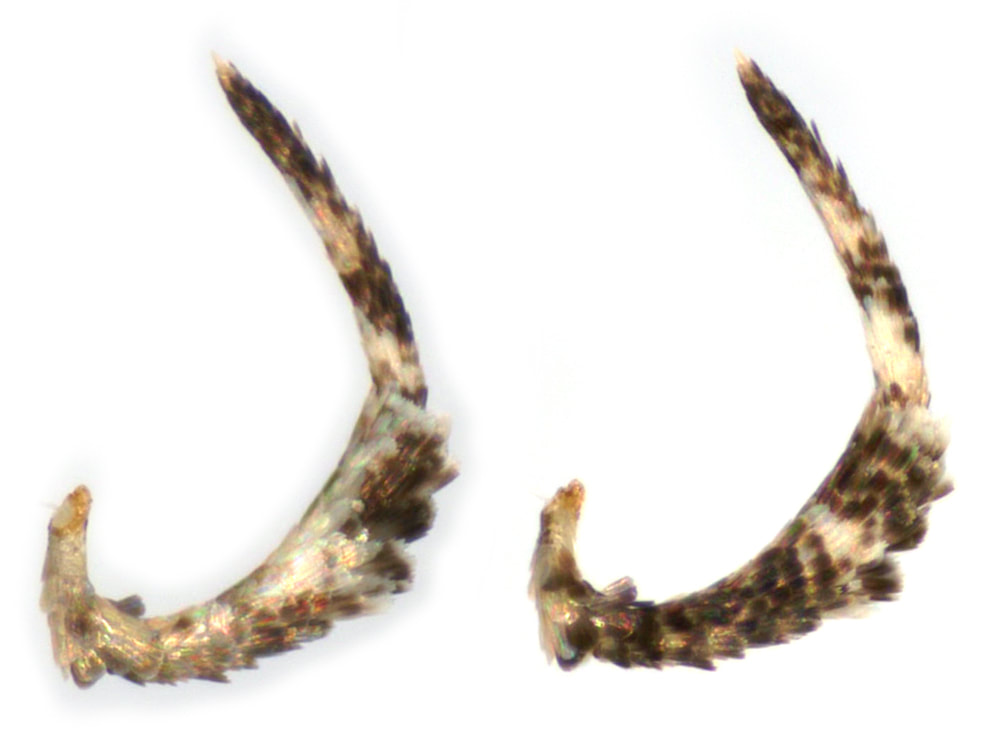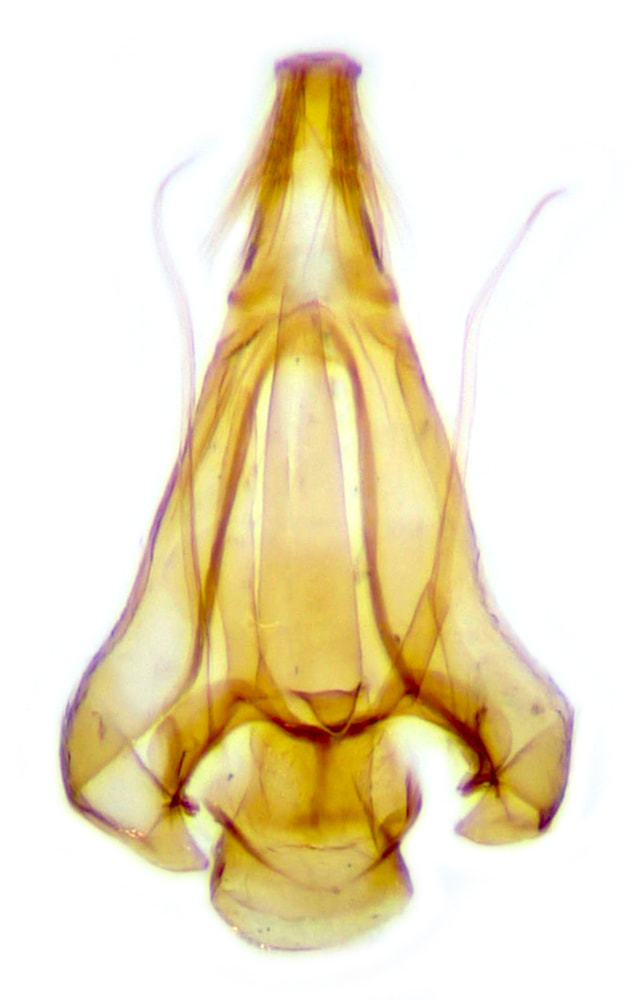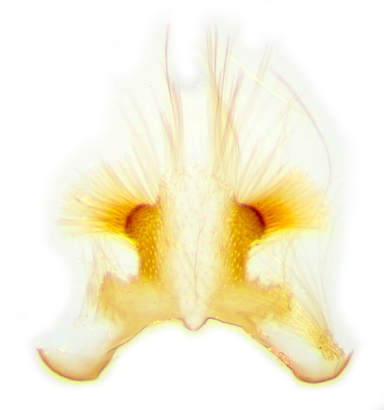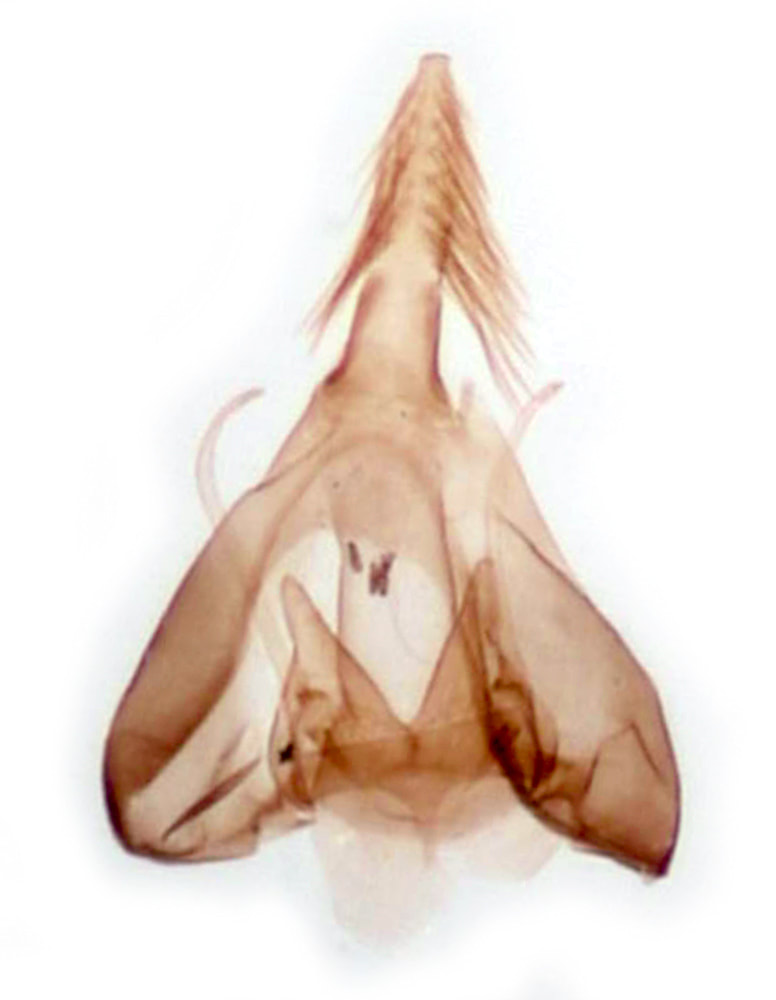Carpatolechia |
Generic features: No generic features are given in MBGBI4.2, but as these 5 species were formerly placed in Teleiodes the features are presumably similar to that genus - which are repeated here: Antenna weakly serrate apically; Labial palp S2 as long as or slightly shorter than S3, S2 thickened with appressed or projecting scales; Ocelli absent; Forewing usually with tufts of raised scales, V7 & 8 stalked, 7 to costa; Hindwing about as broad as forewing, trapezoidal, tornus rounded, termen straight or weakly sinuate, apex moderately to strongly produced, V3-5 separate but close at base, V6&7 connate or stalked; cilia 1.5x width of wing. All have wingspan including the 13-14mm range.
Male genitalia: Gnathos absent or present (when longer than wide), uncus rounded, valvae filamentous with a swollen base
The genital key in MBGBI4.2 does not distinguish Teleiodes from Carpatolechia species. I believe that Teleiodes species possess a ganthos while Carpatolechia species lack one - but need more experience or better reference material to confirm this.
Male genitalia: Gnathos absent or present (when longer than wide), uncus rounded, valvae filamentous with a swollen base
The genital key in MBGBI4.2 does not distinguish Teleiodes from Carpatolechia species. I believe that Teleiodes species possess a ganthos while Carpatolechia species lack one - but need more experience or better reference material to confirm this.
Key to species of Carpatolechia
Forewing |
Labial palp S2 |
|
Black bar at base of costa |
Fuscous with a white apex |
|
White with dark streak on fold OR patch of raised scales dorsal to fold OR heavily suffused |
Fuscous banded whitish |
|
Not as above |
Clear white |
C.alburnella |
Black spot dorsal to 2nd discal stigma |
White with outer side spotted fuscous at base centre and apex |
|
Not as above |
Greyish-white with 2 fuscous bands |
This key is based on that in MBGBI4.2. With experience gained of three of these species so far, I have substantial doubts that any Carpatolechia species can be confidently identified by using external features, without recourse to genital dissection for confirmation of the identification. In many cases the features supporting an identification may only be recognised once the identity is confirmed. In the forewing of C.proximella below it would be hard to conclude that there is definitely not a black bar at the base of the costa or that there is no dark streak in the fold (the elongate 2nd plical stigma could be interpreted as a streak); and there is such a profusion of black spots that identifying which is the 2nd discal stigma is distinctly open to interpretation. In the forewing of C.notatella there is a dark smudge at the position of the "diagnostic" additional spot, that could have been labelled as such had the identity proven to be C.proximella
Male genitalia: The genus is identified from: S8 of separate dorsal and ventral plates; gnathos absent; uncus pointed; digitate lobes on juxta.
The species show show distinctive differences in relative lengths of the valvae and the digitate lobes on the juxta. It is also likely that there are diagnostic differences in the shape of the S8 dorsal plate, but I only have experience of C.notatella and C.proximella and the references available to me do not provide comparative material.
C.proximella - digitate lobes ~½ length of valvae; digitate lobes narrow towards a rounded apex and meet at base to form a distinct 'V'-shape.
C.notatella - digitate lobes ~¾ length of valvae; digitate lobes of ~even width; uncus with a nipple at apex
C.decorella - digitate lobes ~⅓ length of valvae; digitate lobes narrow towards a finely pointed apex and meet at base to form "V"-shape.
C.alburnella - digitate lobes longer than valvae
C.fugitivella - digitate lobes ~½ length of valvae; valvae very long, reaching almost to apex of uncus (with the uncus extended), uncus somewhat rounded.
The species show show distinctive differences in relative lengths of the valvae and the digitate lobes on the juxta. It is also likely that there are diagnostic differences in the shape of the S8 dorsal plate, but I only have experience of C.notatella and C.proximella and the references available to me do not provide comparative material.
C.proximella - digitate lobes ~½ length of valvae; digitate lobes narrow towards a rounded apex and meet at base to form a distinct 'V'-shape.
C.notatella - digitate lobes ~¾ length of valvae; digitate lobes of ~even width; uncus with a nipple at apex
C.decorella - digitate lobes ~⅓ length of valvae; digitate lobes narrow towards a finely pointed apex and meet at base to form "V"-shape.
C.alburnella - digitate lobes longer than valvae
C.fugitivella - digitate lobes ~½ length of valvae; valvae very long, reaching almost to apex of uncus (with the uncus extended), uncus somewhat rounded.
Key to male genitalia |
||
Valvae very long, reaching almost to apex of (extended) uncus |
(Valvae to base of uncus in remaining species) |
|
Digitate lobes longer than valvae |
C.alburnella |
|
Digitate lobes >¾ length of valvae |
Uncus with apical nipple |
|
Digitate lobes ½ length of valvae |
Digitate lobes taper to a rounded apex |
|
Digitate lobes ⅓ length of valvae |
Valvae strongly sclerotised and spinous |
|
Female genitalia: the female genitalia of Teleiodes and Carpatolechia are similar - both have very long posterior apophyses, anterior apophyses that meet in a midline prominence and a signum that consists of a plate with crenulate edges and a broad transverse ridge.
In T.vulgella the anterior and posterior "points" of the signum are notched; in other Teleiodes spp the signum is ovoid so that these "points" of the plate are smoothly rounded. In Carpatolechia spp the signum is more diamond-shaped with truncate anterior and posterior points. Judging from the drawings in MBGBI4.2 (p50, fig 30a-e) and images at Moth Dissection, features of the signum and ventral prominence of A8 are sufficiently distinctive to differentiate the species - but my personal experience is limited. |
Signum |
A8 ventral prominence (midline junction of anterior apophyses) |
|
Longer than wide |
C.alburnella |
|
Transverse ridge broad ~⅓ length of signum |
Almost as wide as long |
C.decorella |
~2x longer than wide |
C.fugitivella |
|
Transverse ridge narrow ~⅕ length of signum |
Posterior margin notched |
C.proximella |
Posterior margin rounded |
C.notatella |
Female genitalia text and key amended 11/09/2021 | C.decorella (male) added 22/11/2023
















